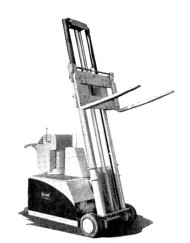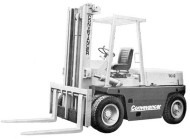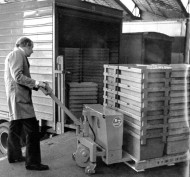 Welcome to episode fiftynine in our exclusive series on the history of the fork lift truck, the machine which over the decades has revolutionised the face of materials handling around the world. In this episode we’re up to 1973, the year Britain entered the EEC and the miners’ strike triggered the three-day week.
Welcome to episode fiftynine in our exclusive series on the history of the fork lift truck, the machine which over the decades has revolutionised the face of materials handling around the world. In this episode we’re up to 1973, the year Britain entered the EEC and the miners’ strike triggered the three-day week.
Our writer is James Brindley, an acknowledged authority on fork lift trucks. James’s distinguished career has involved engineering and management roles with BT Rolatruc and serving as a Director of the FLTA, before he set up the National Fork Truck Heritage Centre in 2004 as Britain’s first such collection open to the public.
The Heritage Centre continues to need your support in 2011, and if you or your company would like to help in any way, you can contact James on the number below. Now sit back and enjoy the latest part of this fascinating series.
Episode 59: 1973 – Britain enters EEC, miners’ strike triggers three-day week
1973 was the year that Britain, Ireland and Denmark entered the EEC. For some UK manufacturers the opportunity to sell, for others it was seen as an unfair playing field where technological barriers, obscure safety regulations and industrial working rules could be used to block a sale. Some of our larger enlightened companies saw things differently and had concentrated, in previous years, on establishing subsidiaries and distributor networks throughout the European zone. This was also the year when raised oil prices triggered a worldwide recession, which was followed in Britain by a three day working week, necessitated by a National miners strike. However despite the situation, our manufacturing business carried on and companies such as Coventry Climax and Conveyancer saw imminent prospects. Conveyancer weighed in with the launch of larger trucks in the “Starline” range. The TC 10 with a 10,000 lb lift capacity and the TC 12 with a 12,000 lb lift capacity were the first of these and sold with a two speed torque converter and a hydraulic accumulator to cushion the load whilst travelling.
 Coventry Climax, five years after becoming a subsidiary of British Leyland, took the opportunity to rationalise its Coventry factory accommodation from three units to two. The Sandy Lane factory would be retained for fork truck assembly and all other work such as manufacturing, servicing and administration was to be concentrated at the Quinton Road premises. This move increased their site area from 579,000 sq ft to 765,000 sq ft and gave them better utilisation of space and an organised materials flow line. The reorganisation was also aimed at bolstering the company’s £10.8 million turnover and increasing their export market. At this time 30% of production was going to export, with virtually none going to the key EEC markets of Germany and France.
Coventry Climax, five years after becoming a subsidiary of British Leyland, took the opportunity to rationalise its Coventry factory accommodation from three units to two. The Sandy Lane factory would be retained for fork truck assembly and all other work such as manufacturing, servicing and administration was to be concentrated at the Quinton Road premises. This move increased their site area from 579,000 sq ft to 765,000 sq ft and gave them better utilisation of space and an organised materials flow line. The reorganisation was also aimed at bolstering the company’s £10.8 million turnover and increasing their export market. At this time 30% of production was going to export, with virtually none going to the key EEC markets of Germany and France.
Fifty years after the production of their first vehicle the Harbilt Company of Market Harborough was subjected to an employee buyout. This necessitated a move to new premises at Riverside where the production of the model 670 platform truck was continued. The main production casualty was the model 731 pedestrian counterbalance which was discontinued.
In the North of Europe two Swedish companies were making good news with BT Industries launching the ML 1200 powered pallet truck and a Company founded by Knut Jacobsson and now called by its new name of Atlet, increases production from its new facilities in Molnlyke.
 In the autumn of 1973 Yale chose this time to launch a new range of petrol and gas engined forklifts. Lifting capacities of 2000 lbs and 3,200 lbs were chosen for the models GP 20 and GP 32 respectively. Both models were available with either pneumatic or super cushioned tyres and a choice of full hydrostatic steering or the economical manual version. Also offered in the sales literature was the choice of manual or fully automatic transmission to complement the industrial, 4 cylinder engine, which was rated at 44 hp at 2800 rpm. Together with maximum operator visibility the truck was said to be one of the quietist on the market at that time.
In the autumn of 1973 Yale chose this time to launch a new range of petrol and gas engined forklifts. Lifting capacities of 2000 lbs and 3,200 lbs were chosen for the models GP 20 and GP 32 respectively. Both models were available with either pneumatic or super cushioned tyres and a choice of full hydrostatic steering or the economical manual version. Also offered in the sales literature was the choice of manual or fully automatic transmission to complement the industrial, 4 cylinder engine, which was rated at 44 hp at 2800 rpm. Together with maximum operator visibility the truck was said to be one of the quietist on the market at that time.
By James Brindley, Director, National Fork Truck Heritage Centre.
To be continued…




Comments are closed.